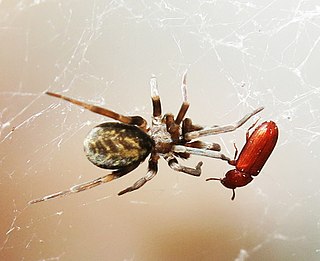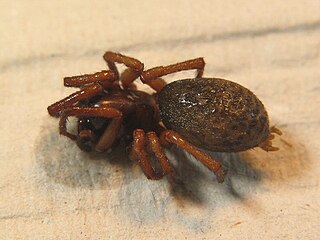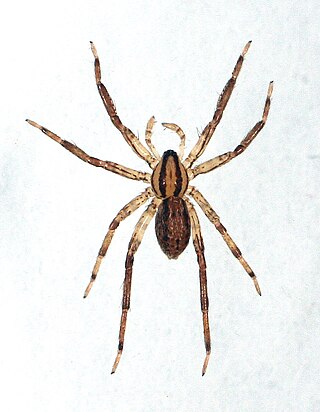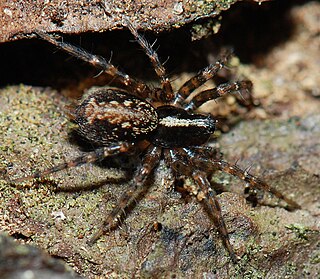
Wolf spiders are members of the family Lycosidae. They are robust and agile hunters with excellent eyesight. They live mostly in solitude, hunt alone, and usually do not spin webs. Some are opportunistic hunters, pouncing upon prey as they find it or chasing it over short distances; others wait for passing prey in or near the mouth of a burrow.

Agelenopsis, commonly known as the American grass spiders, is a genus of funnel weavers described by C.G. Giebel in 1869. They weave sheet webs that have a funnel shelter on one edge. The web is not sticky, but these spiders make up for that by running very rapidly. The larger specimens can grow to about 19 mm in body length. They may be recognized by the arrangement of their eight eyes into three rows. The top row has two eyes, the middle row has four eyes, and the bottom row has two eyes. They have two prominent hind spinnerets, somewhat indistinct bands on their legs, and two dark bands running down either side of the cephalothorax.

Nursery web spiders (Pisauridae) are a family of araneomorph spiders first described by Eugène Simon in 1890. Females of the family are known for building special nursery webs. When their eggs are about to hatch, a female spider builds a tent-like web, places her egg sac inside, and stands guard outside, hence the family's common name. Like wolf spiders, however, nursery web spiders are roaming hunters that don't use webs for catching prey.

The Agelenidae are a large family of spiders in the suborder Araneomorphae. Well-known examples include the common "grass spiders" of the genus Agelenopsis. Nearly all Agelenidae are harmless to humans, but the bite of the hobo spider may be medically significant, and some evidence suggests it might cause necrotic lesions, but the matter remains subject to debate. The most widely accepted common name for members of the family is funnel weaver.

The spider species Tegenaria domestica, commonly known as the barn funnel weaver in North America and the domestic house spider in Europe, is a member of the funnel-web family Agelenidae.

Dictynidae is a family of cribellate, hackled band-producing spiders first described by Octavius Pickard-Cambridge in 1871. Most build irregular webs on or near the ground, creating a tangle of silken fibers among several branches or stems of one plant.

Gasteracantha is a genus of orb-weaver spiders first named by Carl Jakob Sundevall in 1833. Species of the genus are known as spiny-backed orb-weavers, spiny orb-weavers, or spiny spiders. The females of most species are brightly colored with six prominent spines on their broad, hardened, shell-like abdomens. The name Gasteracantha is derived from the Greek gaster (γαστήρ), meaning "belly, abdomen", and akantha (άκανθα), meaning "thorn, spine". Spiny-backed orb-weavers are sometimes colloquially called "crab spiders" because of their shape, but they are not closely related to the true crab spiders. Other colloquial names for certain species include thorn spider, star spider, kite spider, or jewel spider.

Micrathena, known as spiny orbweavers, is a genus of orb-weaver spiders first described by Carl Jakob Sundevall in 1833. Micrathena contains more than a hundred species, most of them Neotropical woodland-dwelling species. The name is derived from the Greek "micro", meaning "small", and the goddess Athena.

Pritha is a genus of crevice weavers that was first described by Pekka T. Lehtinen in 1967.

Drapetisca is a genus of dwarf spiders that was first described by Anton Menge in 1866. Females are 4 to 5 millimetres long, and males are 3 to 4 millimetres long. They are common on tree trunks from July to September, and they feed on insects and smaller spiders.

Titanoeca quadriguttata is a species of spider in the family Titanoecidae. It is widespread in Europe, though absent from Great Britain, and is found in Austria, Belgium, Bulgaria, Corsica, Croatia, Czech Republic, France, Germany, Greece, Hungary, Italy, Liechtenstein, Moldova, Russia, Slovakia, Spain, Switzerland, the Netherlands, Ukraine.

Pachygnatha is a genus of long-jawed orb-weavers that was first described by Carl Jakob Sundevall in 1823.

Inermocoelotes is a genus of funnel weavers that was first described by S. V. Ovtchinnikov in 1999.
Pinkfloydia is a genus of small Australian long-jawed orb-weavers, reaching a maximum lengths of about 4.5 millimetres (0.18 in). It was first described by D. Dimitrov & G. Hormiga in 2011, and contains two species, found in New South Wales and Western Australia: P. harveyi and P. rixi. They have a unique rounded, cone-shaped head structure with one pair of large eyes and three pairs of smaller eyes. The genus is named after British rock band Pink Floyd.

Zora is a genus of spiders in the family Miturgidae, consisting of small to medium entelegyne, ecribellate spiders. They can be identified as they have two claws with claw tufts, distinct longitudinal bands on the cephalothorax, 4-2-2 arrangement of the eight eyes and long overlapping spines on the first two tibiae and metatarsi. Their abdomens show distinct colour patterns which may be useful in identification to species. There are 17 species in the genus which have a Holarctic distribution, mostly in Europe and the Middle East but with two species in North America. The type species is Zora spinimana.

Zora spinimana is a prowling spider of the family Miturgidae with a Palearctic distribution. It is the type species of the genus Zora.

Textrix dendiculata, the toothed weaver, is a funnel web spider of the family Agelenidae found in much of Europe. It was described by the French entomologist Guillaume-Antoine Olivier in 1789. An older name coined by Martini & Goeze in 1778, Aranea cruciger, has been declared a nomen oblitum, allowing Olivier's later name to stand.

Bolyphantes is a genus of dwarf spiders that was first described by Carl Ludwig Koch in 1837.

Asagena is a genus of comb-footed spiders that was first described by Carl Jakob Sundevall in 1833.


















